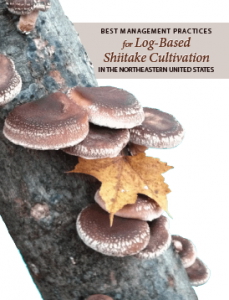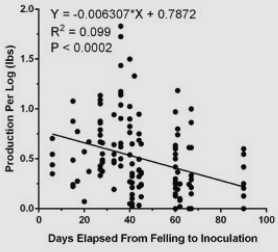
Choosing shiitake varieties and more
 Blog-reader Ron pointed me toward the best shiitake-mushroom writing I've read to date...which you can download free here. Best Management Practices for Log-Based Shiitake Cultivation in the Northeastern United States
has a dry, scientific title, but the interior is full of photos and is
quite easy to read. In fact, I highly recommend you take the time to
peruse all 57 pages if you're thinking of growing shiitakes in logs, but
I'll sum up some of the most interesting points here in case you're
short on time.
Blog-reader Ron pointed me toward the best shiitake-mushroom writing I've read to date...which you can download free here. Best Management Practices for Log-Based Shiitake Cultivation in the Northeastern United States
has a dry, scientific title, but the interior is full of photos and is
quite easy to read. In fact, I highly recommend you take the time to
peruse all 57 pages if you're thinking of growing shiitakes in logs, but
I'll sum up some of the most interesting points here in case you're
short on time.
My favorite part of the
text was the copious data. The file is full of real numbers about the
best time to cut logs (winter and spring), the best number of days to
wait before inoculating (none --- although when I look at the graph
below, I wonder if a parabola wouldn't have been a better fit for the
data than a straight line?),
the best trees to inoculate (oak, sugar maple, ironwood, hop-hornbeam,
and beech), the number of flushes to expect from a log (8 from red oak, 4
to 5 from red maple, all over the course of 3 to 5 years), and much  more.
Interestingly, the scientists in charge even reported on blind taste
tests, where they found that shiitakes grown on ironwood were considered
bland while those on bitternut hickories were prized by top chefs.
more.
Interestingly, the scientists in charge even reported on blind taste
tests, where they found that shiitakes grown on ironwood were considered
bland while those on bitternut hickories were prized by top chefs.
Equally useful was the
authors' sum-up of the differences between the three categories of
shiitakes: wide-range, warm-weather, and cold-weather strains. In the
past, I'd just assumed that these distinctions referred only to fruiting
times, but mushrooms in each category actually tend to act and taste
quite different as well. Cold-weather strains are nice for low-work
backyard producers like us since they generally start fruiting on their
own (actually preferring not to be shocked
in most cases), can be inoculated into larger logs since you won't have
to wrestle the substrate into and out of water to force fruiting, and
often have the most intense flavor in their fruits. Wide-range strains
are also a good choice for beginners because logs fruit quickly after
inoculation and recover rapidly between shock treatments. Finally,
warm-weather strains are optimal if you only have softer hardwoods like
red maples available, or if you need to make sure you'll have a
dependable harvest throughout the summer months.
Our spawn is already in
the mail as I type, so it's too late to pick out varieties with this new
information in hand. But I'm hopeful the types of shiitakes we chose
will do well on our farm. Here are the descriptions for our three new
strains (shamelessly copied from Field and Forest Products' website):
- Snow Cap Shiitake (cold weather) --- Produces beautiful, uniform, thick fleshed caps tufted with white lacey ornamentation. A long natural outdoor season makes it a favorite for those who like to visit their logs regularly. Heaviest fruiting occurs early spring and late fall. Possibly the best winter strain in the South.
- WW70 Shiitake (warm weather) --- This warm/cool weather strain has characteristics close to a CW strain. Its late summer - late fall fruiting period outdoors is one of the longest of all our strains. It is also one of the most beautiful, with dark caps and lots of contrasting ornamentation. Please note that WW70™ does not respond well to force fruiting.
- Native Harvest Shiitake (wide range) ---
Naturalized on our farm several years ago, this strain has been tested
from North to South and the results are the same: a very fast, vigorous
strain with excellent quality. First found on oak, it is also a good
producer on Red Maple. Unlike other wide range species, Native Harvest™
also gives a late fall flush; an added bonus for the Thanksgiving table!
Spawn run is 6 to 12 months.
Want more in-depth information? Browse through our books.
Or explore more posts by date or by subject.
About us: Anna Hess and Mark Hamilton spent over a decade living self-sufficiently in the mountains of Virginia before moving north to start over from scratch in the foothills of Ohio. They've experimented with permaculture, no-till gardening, trailersteading, home-based microbusinesses and much more, writing about their adventures in both blogs and books.
Want to be notified when new comments are posted on this page? Click on the RSS button after you add a comment to subscribe to the comment feed, or simply check the box beside "email replies to me" while writing your comment.

The correlation coefficient R² is pretty low for the lineair fit. Both for a small amount of days and for a large amount of days the sample sizes seem to be a lot smaller than for those in between. That will influence the fit. Also, the smaller the sample size of a certain amount of days, the harder it is to draw valid conclusions from the data.
Given the way the data are spread out (more or less in a square with a bulge on top), it doesn't seem to me that it makes sense to put a lineair least squares fit through them.
What I would conclude from the given graph is that you can expect between 0 and 1 lb per log, almost independent of the time passed between felling and inoculation. So based on this data, other factors than the age of the log determine the the yield of a log.
I think I've read the entire archive, and I recall you experimenting with a number of different mushroom varieties and methods, but I don't recall reading about any attempts to grow Chicken Of The Woods mushrooms.
Have you tried them yet? If so, what was the outcome?
They're a particular favorite of mine, but they're bloody hard to find in the stores, so I'd love to grow my own.
This reminds me of conversations we had with our neighbor, who was, for real, a rocket scientist, having worked on the space shuttle. Mostly, after a similar type discourse, I would reply, "Huh?" 😊
Anna
I failed to mention, of course there is a book
http://farmingthewoods.com/
Ken Mudge and Steve Gabriel have authored a fine book about using your wooded land for more than just logging (mushroom, ramps, paw paw, nut, ferns) Steve Gabriel has a strong foundation based on permaculture.
For interested parties, there is a wealth of information on
http://blogs.cornell.edu/mushrooms/
but, even better, there is a listserv
http://blogs.cornell.edu/mushrooms/join/
Chock full of early email traffic on the shiitake mushroom growing / research process. Steve Gabriel hosts it and would better explain the graphs. I enjoyed reading past posts to 2010. Learn from others mistakes.
I will start with 100 Sugar Maple logs end of March here in Central NY.
Daniel and Roland --- You made my day. Eyeballing the graph, I was going to say the peak was at about 25 to 30 days.
Eyeballing the graph, I was going to say the peak was at about 25 to 30 days.
Of course, I think their data is probably pretty weak to begin with because my understanding is that it comes from a variety of different farmers in different locations throughout the northeast growing different varieties of shiitakes on different species of trees. Phew! So many differences! Maybe they'll do a controlled experiment at a later date.
deb --- Sorry you found the geekiness less fun.
Dave --- Great question! I've eaten Chicken of the Woods once, but it wasn't too fresh and the taste was only so-so, so I wasn't terribly excited about it (especially after I saw that the species wasn't on the list of easy-to-grow mushrooms). Tradd Cotter's book recommends:
Ron --- I realized partway through the article that Ken Mudge was also the author of the book I'd been drooling over, which does make me more likely to buy it. Books from Chelsea Green are always so darned expensive or I would have read it already! It's top of my splurge list though, so I'll likely read it soon.